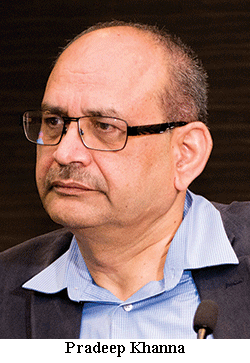 The other day, I went to meet someone in downtown Sydney, Australia. On my way back on the local train, I looked at my mobile to check my emails and found a message asking me whether I would like to connect on Linkedin with the person I had just met. This was artificial intelligence (AI) at play.
The other day, I went to meet someone in downtown Sydney, Australia. On my way back on the local train, I looked at my mobile to check my emails and found a message asking me whether I would like to connect on Linkedin with the person I had just met. This was artificial intelligence (AI) at play.
You better start believing it. We now live in a brave new world where AI is the next frontier. Words and terminology such as bots, chatbots, teacherbots, digital assistants, machine learning among others are fast becoming everyday communication currency and the sooner we know what they mean and signify, the better.
Just like virtual reality, AI has been around for quite sometime. In fact, I remember studying AI as a subject when doing my second Masters degree in computer science at the University of Technology in Sydney 17 years ago. But now push has come to shove and AI has begun to shape how we live and work and will soon reshape how the next generation learns. But first, 21st-century learners need to become acquainted with bots, chatbots and teacherbots.
A bot is software designed to automate repetitive tasks. An example is bots used for searching and cataloguing web pages for search engines. Another example is shopping bots which pull out prices of an item from different online vendors of goods and services. Other examples are bots which make restaurant reservations, note appointments in calendars and search and display information.
Chatbots are bots that conduct conversations mirroring real-life conversations. They can either be simple and rule-based or more sophisticated versions using artificial intelligence to become smarter after every interaction. The popularity of messaging apps has been raising the demand for chatbots. The rise of chatbots is testified by user migration from the web to apps and recently from apps to chatbots.
Like a bot or a chatbot, a teacherbot can be simple and rule-based or smart and AI-driven. Rule-based teacherbots can automate simple teaching tasks whereas smart AI-based teacherbots can become teaching assistants (TAs). A yet smarter AI-based teacherbot can also graduate to becoming a personal tutor.
There are two well-known instances of teacherbot pilot projects engineered at the University of Edinburgh, UK and Georgia Tech, USA.
The Edinburgh University’s teacherbot project was initiated in April 2015 by the varsity’s professor of digital education Sian Bayne, in collaboration with the school of informatics and the Edinburgh College of Art. Botty, as this teacherbot was christened, was engineered to engage on Twitter with students of Edinburgh University’s e-learning and digital cultures Mooc (massive open online course) programme on the Coursera platform. Botty’s primary function was to discharge the functions of a teaching assistant. It could answer simple questions on deadlines, course content, etc. It also answered some complex questions based on AI that had been developed from stored tweets under the Twitter hashtag #edcmooc. In Botty’s case, the students were aware that a teacherbot, not a human being, was answering their queries.
Georgia Tech’s teacherbot was developed by Ashok Goel, a professor of artificial intelligence at the university. Typically, the 300 students at Georgia Tech’s online AI programme posted around 10,000 queries per semester in online forums. Many of these questions were duplicates and repetitive. This prompted Goel to design teacherbots which would respond to standard queries. Leveraging IBM Watson’s technology platform and a databank of 40,000 common questions and answers, he developed an overlaying smart AI for the teacherbot named ‘Jill Watson’. Georgia Tech students were not informed that Jill was a teacherbot.
Initially, the responses of Jill Watson launched in January 2016, weren’t sufficiently complete. Therefore they were modified by human TAs before being posted online. But by April, Jill became sufficiently ‘intelligent’ to answer repetitive questions without human intervention.
The potential of artificial intelligence to disrupt conventional education and skills training programmes is immense. In the distant future, smart AI-based teacherbots will replace humans and provide personalised learning. Meanwhile automated AI-driven assessments have emerged in education and skills training, and are proving particularly useful when a large number of assessments need to be done online. Use of technologies such as Facebook’s facial recognition technology and proctoring are classic examples.
However, these are early days of AI in education. Currently, the focus is on automating routine teaching tasks. This is akin to the robotic and process automation (RPA) implementation already introduced for shopfloor tasks in the manufacturing industry.
The application of AI in education and skills training will follow its application in industry and social life in general. But with major technology innovators investing heavily in artificial intelligence, it’s certain that all work and learning will be reshaped by AI in the mid-term future.
(Pradeep Khanna is founder & CEO of the Sydney-based Global Mindset and Technology-enabled Innovations in Learning & Teaching)